本文尝试梳理一遍HashMap,基于Java8。先看一个使用示例:
public static void main(String[] args) {
// init
Map<Integer, Integer> map = new HashMap<>();
// put
IntStream.range(0, 20).forEach(item->map.put(item,item+1));
// iterator
map.forEach((k,v)-> System.out.println("k:"+k+" v:"+v));
// get
System.out.println(map.get(1);
}
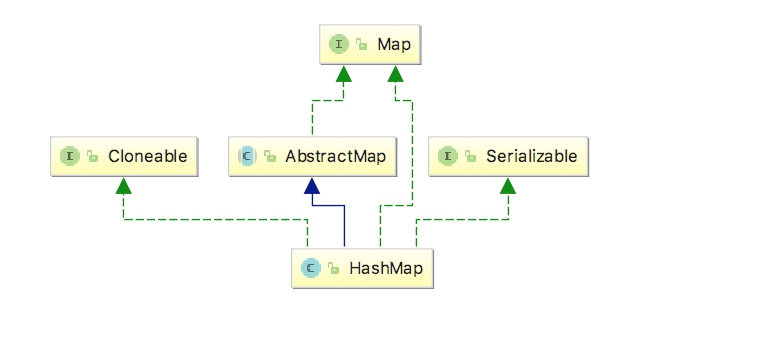 继承AbstractMap,实现 Cloneable, Serializable。
重要filed:
继承AbstractMap,实现 Cloneable, Serializable。
重要filed:
- initialCapacity:初始容量,是哈希表创建中桶的数量。默认16(1«4)
- loadFactor:加载因子(默认0.75),指容量自动增加之前可以达到多满的一个系数。
所以,使用时,如果明确知道map的容量,可以定一个初始值,避免自动扩容的消耗。
常量:
/**
* 默认的初始容量(容量为HashMap中槽的数目)是16
*/
static final int DEFAULT_INITIAL_CAPACITY = 1 << 4; // aka 16
/**
* 最大容量 : 必须是2的幂且小于2的30次方,传入容量过大将被这个值替换
*/
static final int MAXIMUM_CAPACITY = 1 << 30;
/**
* 默认加载因子
*/
static final float DEFAULT_LOAD_FACTOR = 0.75f;
/**
* 链表转为红黑树的临界值
*/
static final int TREEIFY_THRESHOLD = 8;
/**
* 删除冲突节点后,hash相同的节点数目小于这个数,红黑树就恢复成链表
*/
static final int UNTREEIFY_THRESHOLD = 6;
/**
* 可能被树化的最小容量
*/
static final int MIN_TREEIFY_CAPACITY = 64;
初始化
如果使用模式默认构造方法,loadFactor=0.75f:
public HashMap() {
this.loadFactor = DEFAULT_LOAD_FACTOR; // all other fields defaulted
}
指定容量初始化:
public HashMap(int initialCapacity, float loadFactor) {
if (initialCapacity < 0)
throw new IllegalArgumentException("Illegal initial capacity: " + initialCapacity);
if (initialCapacity > MAXIMUM_CAPACITY)
initialCapacity = MAXIMUM_CAPACITY;
if (loadFactor <= 0 || Float.isNaN(loadFactor))
throw new IllegalArgumentException("Illegal load factor: " +loadFactor);
this.loadFactor = loadFactor;
this.threshold = tableSizeFor(initialCapacity);
}
threshold: (capacity * load factor) , 扩容时容量大小。但此处使用了方法tableSizeFor。
// 返回容量对应的2的幂:比如cap=31,return 32,cap=33,return 64
static final int tableSizeFor(int cap) {
int n = cap - 1;
n |= n >>> 1;
n |= n >>> 2;
n |= n >>> 4;
n |= n >>> 8;
n |= n >>> 16;
return (n < 0) ? 1 : (n >= MAXIMUM_CAPACITY) ? MAXIMUM_CAPACITY : n + 1;
}
1. PUT
Put主要包含以下步骤:
- 对key的hashcode做hash处理,再获取index
- 如果没有hash碰撞,直接put
- 如果碰撞,以链表形式存储
- 如果链表过长,装换为红黑树
- 如果已经存在,替换value
- 如果达到扩展临界值,则扩容
数据结构示意图:
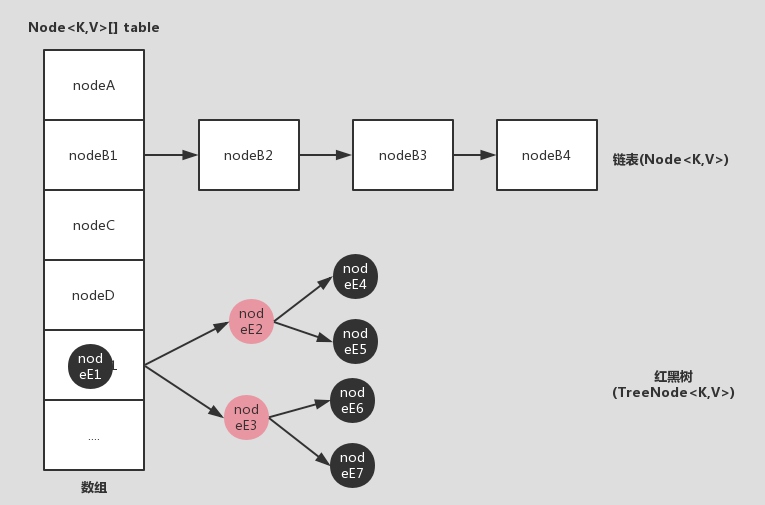 从图中看出,HashMap有数组、链表、红黑树等数据结构。使用数组是为方便hash后定位到具体节点(也作bucket),时间复杂度O(1),如果bucket位置相同,使用链表方便插入,但是链表过长,查找时间复杂度增加O(n)。使用红黑树,查找时间复杂度O(logn)。
从图中看出,HashMap有数组、链表、红黑树等数据结构。使用数组是为方便hash后定位到具体节点(也作bucket),时间复杂度O(1),如果bucket位置相同,使用链表方便插入,但是链表过长,查找时间复杂度增加O(n)。使用红黑树,查找时间复杂度O(logn)。
Node和TreeNode结构如下:
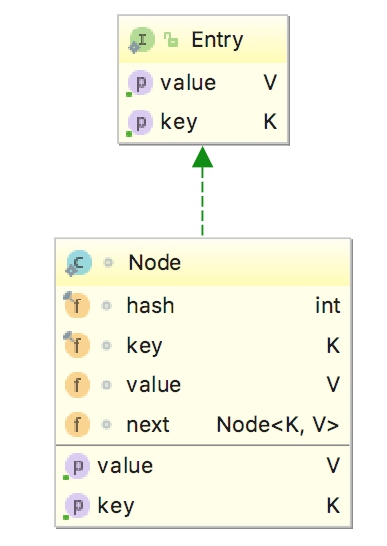
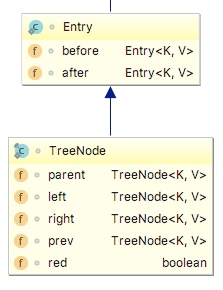
源码
/**
* 1. 存放key-value,如果key已经存在,则替换掉
* 2. 如果已经有key,返回对应value,否则返回null
* 3. 对 key 作hash并传递给putVal方法
*/
public V put(K key, V value) {
return putVal(hash(key), key, value, false, true);
}
static final int hash(Object key) {
int h;
// key 为null 返回 0
// key 非null:获取hashcode 和hashcode无符号右移16位安位与,即大于2的16次方后,重新调整hashcode。
return (key == null) ? 0 : (h = key.hashCode()) ^ (h >>> 16);
}
例如”string“对应的hash值如下:
h : 1100 1010 1101 0101 0110 0000 0001 0001
h>>>16: 0000 0000 0000 0000 1100 1010 1101 0101
^ 1100 1010 1101 0101 1010 1010 1100 0100
final V putVal(int hash, K key, V value, boolean onlyIfAbsent, boolean evict) {
Node<K,V>[] tab; Node<K,V> p; int n, i;
// tab为空则通过resize创建
if ((tab = table) == null || (n = tab.length) == 0)
n = (tab = resize()).length;
// 计算index = (n - 1) & hash,如果此下标Node空,新建一个Node
if ((p = tab[i = (n - 1) & hash]) == null)
tab[i] = newNode(hash, key, value, null);
else {
Node<K,V> e; K k;
if (p.hash == hash &&
((k = p.key) == key || (key != null && key.equals(k))))
// hash相同,key相同:节点存在
e = p;
else if (p instanceof TreeNode)
// 该链为树
e = ((TreeNode<K,V>)p).putTreeVal(this, tab, hash, key, value);
else {
// 链表
for (int binCount = 0; ; ++binCount) {
if ((e = p.next) == null) {
p.next = newNode(hash, key, value, null);
if (binCount >= TREEIFY_THRESHOLD - 1) // -1 for 1st
// 链表转为树
treeifyBin(tab, hash);
break;
}
if (e.hash == hash &&
((k = e.key) == key || (key != null && key.equals(k))))
break;
p = e;
}
}
if (e != null) { // existing mapping for key
V oldValue = e.value;
if (!onlyIfAbsent || oldValue == null)
e.value = value;
afterNodeAccess(e);
return oldValue;
}
}
++modCount;
// size 叨叨临界值,扩容
if (++size > threshold)
resize();
afterNodeInsertion(evict);
return null;
}
上述 内部类Node很重要,用来存储数据。如果put发现tab下标(index)对应的值为空,直接new 一个Node存放。
tab[i] = newNode(hash, key, value, null);// 第一个node
p.next = newNode(hash, key, value, null);// 链表添加node
2. 扩容
扩容resize,当bucket数量超过threshold,需要对数组table扩容,否则hash碰撞太厉害,影响性能。也就是put源码中的:
if (++size > threshold){
resize();
}
每次扩容,新容量(newCap)都是原来的2倍,重新分配每个桶上的数据,下面重点看如何分配: 从一个示例开始:
public class App {
public static void main(String[] args) {
Map<String, String> map = new HashMap<>();
for (int i = 0; i < 16; i++) {
map.put("key" + i, "value" + i);
}
}
}
case1: 没有碰撞,不用扩容 循环插入16个数据从key0->key15。初始化map后:
cap = 16
threshold = 16 * 0.75 = 12
对于put("key0","value0"),key0的hash值为十进制为3288451,则:hash & (cap-1)
hash 0011 0010 0010 1101 1000 0011
n-1 0000 0000 0000 0000 0000 1111
rst 0000 0000 0000 0000 0000 0011
结果是: 3 表示key0位置在数据是table[3] = node(3288451,“key0”,“value0”,null);
case2: 碰撞,转为链表
对于put("key12","value12")
key12的hash值为十进制为101945043, 则:hash & (cap-1)
0110 0001 0011 1000 1110 1101 0011
0000 0000 0000 0000 0000 0000 1111
0000 0000 0000 0000 0000 0000 0011
结果是3,和key0位置相同,赋值为key0.next
p.next = newNode(hash, key, value, null);
如下图:
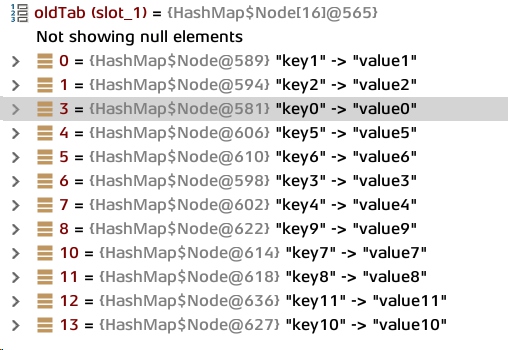 此时,size = 13 > 12。到达扩容界限,进行扩容:
此时,size = 13 > 12。到达扩容界限,进行扩容:
cap = 32
threshold = oldThr <<1 = 24
重新分配数据,还是以key0和key12为例: hash & (cap«1)-1
key0
hash 0011 0010 0010 1101 1000 0011
(n<<1)-1 0000 0000 0000 0000 0001 1111
rst 0000 0000 0000 0000 0000 0011
结果还是3,还是原来桶的位置;
key12
0110 0001 0011 1000 1110 1101 0011
0000 0000 0000 0000 0000 0001 1111
0000 0000 0000 0000 0000 0001 0011
结果是16 + 3 = 19, 位置改变,重新分配。
从key12 的例子可以看到。 hash & (cap-1): 其中hash值不变,不需要重新计算, cap左移一位(扩容一次)
- 如果hash对应位置上是0,则hash & (cap-1)结果不变
- 如果hash对应位置上是1,结果是(hash & (cap-1) + cap = hash & (cap « 2 -1),即原值+cap
这样,数据迁移的成本不是很高。
下面是resize源码:
final Node<K,V>[] resize() {
Node<K,V>[] oldTab = table;
int oldCap = (oldTab == null) ? 0 : oldTab.length;
int oldThr = threshold;
int newCap, newThr = 0;
if (oldCap > 0) {
// 超过最大值就不再扩容
if (oldCap >= MAXIMUM_CAPACITY) {
threshold = Integer.MAX_VALUE;
return oldTab;
}else if ((newCap = oldCap << 1) < MAXIMUM_CAPACITY && oldCap >= DEFAULT_INITIAL_CAPACITY)
newThr = oldThr << 1; // 扩展为原来两倍(double threshold)
}else if (oldThr > 0) {// initial capacity was placed in threshold
newCap = oldThr;
}else { // zero initial threshold signifies using defaults
newCap = DEFAULT_INITIAL_CAPACITY;
newThr = (int)(DEFAULT_LOAD_FACTOR * DEFAULT_INITIAL_CAPACITY);
}
// 计算新threshold
if (newThr == 0) {
float ft = (float)newCap * loadFactor;
newThr = (newCap < MAXIMUM_CAPACITY && ft < (float)MAXIMUM_CAPACITY ?(int)ft : Integer.MAX_VALUE);
}
threshold = newThr;
@SuppressWarnings({"rawtypes","unchecked"})
Node<K,V>[] newTab = (Node<K,V>[])new Node[newCap];
table = newTab;
if (oldTab != null) {
for (int j = 0; j < oldCap; ++j) {
Node<K,V> e;
if ((e = oldTab[j]) != null) {
oldTab[j] = null;
if (e.next == null)
newTab[e.hash & (newCap - 1)] = e;
else if (e instanceof TreeNode)
// 对树的处理
((TreeNode<K,V>)e).split(this, newTab, j, oldCap);
else { // preserve order
Node<K,V> loHead = null, loTail = null;
Node<K,V> hiHead = null, hiTail = null;
Node<K,V> next;
// 对链表的处理
do {
next = e.next;
if ((e.hash & oldCap) == 0) {
if (loTail == null)
loHead = e;
else
loTail.next = e;
loTail = e;
}
else {
if (hiTail == null)
hiHead = e;
else
hiTail.next = e;
hiTail = e;
}
} while ((e = next) != null);
if (loTail != null) {
loTail.next = null;
newTab[j] = loHead;
}
if (hiTail != null) {
hiTail.next = null;
newTab[j + oldCap] = hiHead;
}
}
}
}
}
return newTab;
}
知道put和resize方法,get方法就比较简单了。这儿不作分析。
总结:
- Hashmap由3种数据结构组成,分别是数组、链表、红黑树。数组存储相「桶」,桶里面是链表或红黑树,桶的定位通过hashcode和(hashcode»>16)异或计算结果。
- hash碰撞问题:如果,少量数据通过链表,数据多通过红黑树。但如果碰撞过于严重,其实效率就退化为红黑树的效率,O(1)->O(logN)。通过动态扩容解决。
- 动态扩容:数据达到某个阈值进行扩容,但扩容需要对所有数据重新hash,可能会导致扩容时出现严重性能问题;hashMap都是原来两倍,保证数据迁移要么在原位,要么+oldCap,减少重新计算桶和数据迁移复杂性。